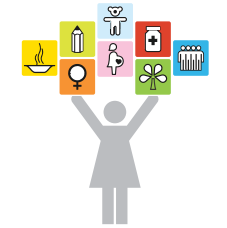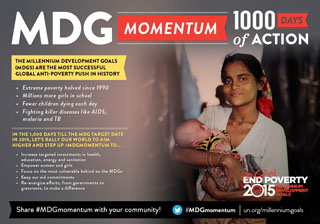1000 Days of Action

Goal 1 | Goal 2 | Goal 3 | Goal 4 | Goal 5 | Goal 6 | Goal 7 | Goal 8
Press release | Multimedia | Join the conversation | Post-2015
As of 5 April 2013, only 1,000 days remain until the end of the 2015 target date for achieving the eight Millennium Development Goals (MDGs). The eight MDGs – which range from halving extreme poverty to promoting gender equality to providing universal primary education by the target date of 2015 – form an internationally agreed blueprint which countries and leading development institutions have signed onto. Since their adoption in 2000, the MDGs have made a huge difference, helping to set global and national priorities and fuel action on the ground. They have raised awareness and shaped a broad vision for development work across the world.
The MDGs are not just abstract or aspirational targets. Achieving the Goals is about ensuring certain basic human rights for all, and making a real difference in people’s lives. UN Women is actively working on the achievement of the MDGs, for which women and girls play a pivotal role, as well as for MDG3, which specifically focuses on promoting gender equality and women’s empowerment.
Snapshot of Progress: MDG targets for reducing poverty[i], improving access to safe drinking water[ii], and improving the lives of 200 million slum dwellers[iii] have been met. More kids than ever are attending primary school[iv] with parity achieved between boys and girls[v]. Child deaths have dropped dramatically[vi], and targeted investments in fighting malaria, HIV/AIDS and tuberculosis have saved millions of lives[vii].
While significant progress has already been made, gaps still remain. Much more needs to be done, particularly when it comes to implementation on the ground, including for achieving gender equality and women’s empowerment, and addressing the gender dimensions of the all the eight goals. Studies also show that millions of people – particularly the poorest and most marginalized, minorities, women and girls – are being left behind.
We have 1,000 Days to the end of 2015 – 1,000 Days for action.
 With 1,000 Days to achieve the MDGs, efforts have to accelerate action and scale up what works – with contributions from Governments, the international community, civil society and the private sector. Focusing on reducing inequalities on many fronts – such as improving food security, maternal health, water and sanitation, rural development, environmental sustainability and responses to climate change – is critical at this juncture.
With 1,000 Days to achieve the MDGs, efforts have to accelerate action and scale up what works – with contributions from Governments, the international community, civil society and the private sector. Focusing on reducing inequalities on many fronts – such as improving food security, maternal health, water and sanitation, rural development, environmental sustainability and responses to climate change – is critical at this juncture.
Evidence shows that gender equality and women’s empowerment is a cornerstone to accelerating and sustaining MDG progress and furthering all the Goals. According to the World Bank, ensuring equal access for women and girls to education, nutrition, basic services, health care, employment, economic opportunities and decision-making at all levels has proven to be one of the most powerful drivers of progress across all the Goals[viii].
Find out more about how women and girls are faring in progress towards each of these goals, and UN Women’s ongoing efforts, click on a specific goal:

Multimedia
Momentum towards meeting the MDGs
Video message from UN Secretary-General Ban Ki-moon for 1,000 Days to the Deadline of the Millennium Development Goals
Multimedia presentation of the MDGs Gender Chart 2012
Credit: UN Women/Laura Turquet and United Nations/Keiko Osaki Tomita
Join the conversation
#MDGmomentum
Social media will play a major role in observing the milestone. A global social media surge on Friday, 5 April – involving 1,000 consecutive minutes of digital engagement – will promote #MDGmomentum and the need to rally the world to step up efforts to achieve the eight Goals as 2015 approaches.
As part of the #MDGmomentum digital rally, UN Women held an #AskUNWomen Twitter chat with Deputy Executive Director John Hendra on 5 April on MDG progress for women and girls worldwide. Follow @UN_Women and the hashtag #AskUNWomen on Twitter. See the Storify here.
Post-2015
At the 2010 High-level Plenary Meeting of the UN General Assembly to review progress towards the MDGs, governments called not only for accelerating progress towards achieving the MDGs, but also for thinking on ways to advance the UN development agenda beyond 2015. UN Women is actively involved in the planning and discussions around a post-2015 development agenda. UN Women is advocating for the inclusion of gender specific goal, and gender-specific indicators for all the other goals.
Read more about our work on the post-2015 agenda here.
Visit a survey website where you can make your voice heard and help shape the inter-governmental discussions. http://www.myworld2015.org/
Related links:
A Gateway to the UN System’s work towards the MDGs
The Millennium Development Goals Report 2012
[i]The number of people living on less than $1.25 a day fell from over 2 billion in 1990 to 1.4 billion in 2008. At the same time, the corresponding poverty rate dropped from 47 per cent to 24 per cent. Preliminary estimates indicate that the global poverty rate at $1.25 a day fell in 2010 to less than half the 1990 rate. If these results are confirmed, the first target of the MDGs—cutting the extreme poverty rate to half its 1990 level—will have been achieved at the global level well ahead of 2015. [MDG Report 2012]
[ii]The world has met the MDG drinking water target of halving the number of people without sustainable access to safe drinking water, five years ahead of schedule. The number of people using improved drinking water sources reached 6.1 billion in 2010, up by over 2 billion since 1990. Or in 2010, 89 per cent of the world’s population was using improved drinking water sources, up from 76 per cent in 1990. [MDG Report 2012]
[iii]The share of urban residents in the developing world living in slums declined from 39 per cent in 2000 to 33 per cent in 2012. More than 200 million gained access to either improved water sources, improved sanitation facilities, or durable or less crowded housing. This achievement exceeds the target of significantly improving the lives of at least 100 million slum dwellers, well ahead of the 2020 deadline. [MDG Report 2012]
[iv]The net primary school enrolment ratio in developing regions reached 90 per cent in 2010, up from 82 per cent in 1999. [MDG Report 2012]
[v]The ratio between the enrolment rate of girls and that of boys grew from 91 in 1999 to 97 in 2010 for all developing regions. The gender parity index value of 97 falls within the plus-or-minus 3-point margin of 100 per cent, the accepted measure for parity. [MDG Report 2012]
[vi] Despite population growth, the number of deaths in children under five worldwide declined from 12.4 million in 1990 to 6.9 million in 2011, which translates into about 14,000 fewer children dying each day. [MDG Report 2012 Addendum to Goal 4]
[vii]At the end of 2011, 8 million people were receiving antiretroviral therapy for HIV or AIDS in developing regions. This total constitutes a 60 per cent increase from December 2009. Globally, deaths from tuberculosis have been falling since 2002, and current projections suggest that the 1990 death rate from the disease will be halved by 2015. Deaths from malaria fell by 17 per cent globally since 2000. [MDG Report 2012 and World AIDS Day Report 2012]
[viii]Countries that invest in promoting the social and economic status of women tend to have lower poverty rates. For example, an extra year of secondary schooling for girls can increase their future wages by 10 to 20 per cent. Educating women also has a positive impact on health: Women with some formal education are more likely to seek medical care during pregnancy, ensure their children are immunized, be better informed about nutritional requirements, and adopt improved sanitation practices. [World Bank]